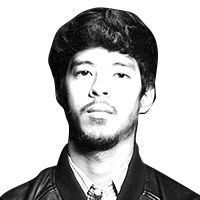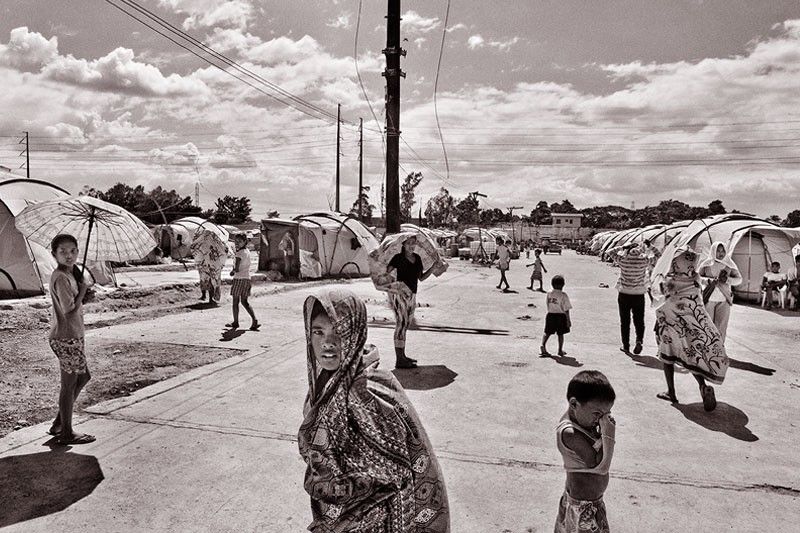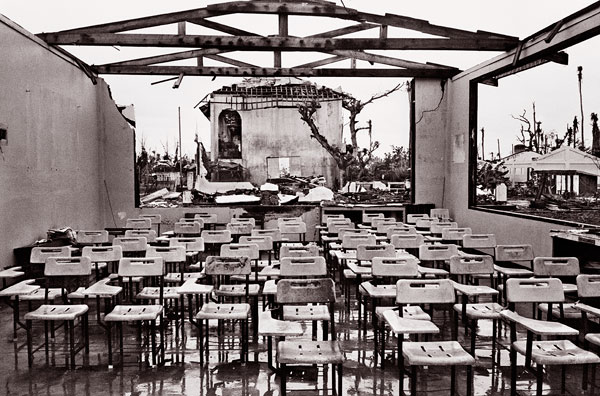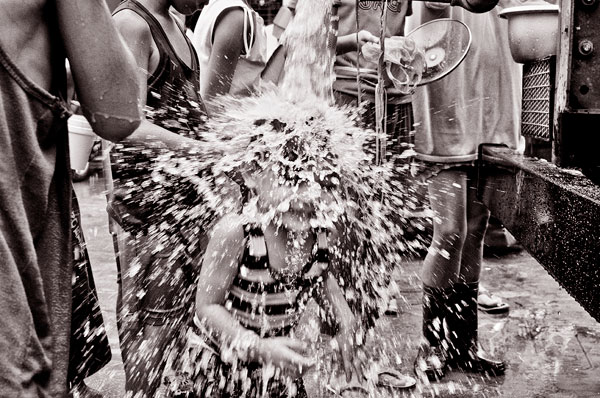Storm of the century


“We don’t need much scientific facts in order to wake up to the new reality that we are vulnerable to the adverse effects of climate change,” says Veejay Villafranca on the common thread that runs through the photographs in Signos. Photo by Veejay Villafranca
In this year’s Art Fair Philippines, it is the photographs, perhaps tellingly, that resonate with much more urgency than any other image. It might not be ideal to pit them against painting or sculpture, or an installation, for each medium has a different way of communicating. But it is undeniable how photographs are much damningly compelling in their clarity, and at the same time, offer a careful and layered view of their subjects — be it barren landscapes, displaced communities, or the worst night of someone’s life — the seen mingling with the unseen, toying with our perception.
It is reassuring that a well-received event such as Art Fair Philippines would put a spotlight on photojournalism, and may even be long overdue as the country is home to some of the best photojournalists working today.
In “Provocations: Philippine Documentary Photography,” curated by Neal Oshima and Angel Velasco Shaw, “To shoot is to testify.”
RJ Fernandez’s photographs of Cordillera mines might seem mesmerizing at first, the broken geometrics of each landscape, shot from above, seem larger than life, but it becomes more apparent that these are images of destruction and how humans continue to leave a cruel imprint.
Carlo Gabuco’s photographs of urban Manila can be serene (a child skipping above tombs) — and harried (weary passengers on a bus making their way home) but a sinister undercurrent of violence always lurks in the pictures: the Big Brother-like phantom of tokhang leaving a grisly imprint.

“Climate change has been staring at us for many decades,” says Veejay Villafranca. Photos from Signos also appear at the “Provocations: Philippine Documentary Photography” section of Art Fair Philippines.
Even Jes Aznar’s documentation of the Marawi siege, a story that has been told over in the news cycle, remains harrowing — proof that photojournalism is essential in the Instagram age when images are reduced to aesthetics.
“The use of images to propel fake news is prevalent,” says Veejay Villafranca, who is also part of “Provocations.” “The role of visual journalists should be strengthened and photojournalists should adapt and arm themselves with the latest communication tools in order to continue to reach out to their audience. Since the big media shift; closure of magazines, dwindling assignments, and issues haunting the photojournalism industry, it is high time for photographers or visual journalists to strengthen the two important disciplines: photography and journalism.”
“We, as witnesses, should strive to continue reporting on a wide array of stories and make the best effort to reach our audiences,” he adds.
Villafranca’s work in “Provocations” are excerpts from his new book, Signos, a visual documentation of how climate change has slowly changed the country, and continues to do so by displacing communities.
Signos has been six years in the making, capturing snapshots of the six million people living at the mercy of extreme weather, from drought to floods, and struggling from its effects, whether it is food, housing, health, or sanitation.

The book has been six years in the making, capturing snapshots of the six million people living at the mercy of extreme weather, from drought to floods, and struggling from its effects, whether it is food, housing, health, sanitation.
Here, Villafranca discusses his process, the continuing relevance of photo documentation as practice, and the unbearable truth of climate change.
SUPREME: Signos is a compilation of six years’ worth of photographs. How did you begin the selection, especially for such a subject?
VEEJAY VILLAFRANCA: Much more than a compilation, Signos was specifically made in order to follow the lives of the communities displaced by extreme weather condition or more commonly known as climate change. After covering different aftermaths from Typhoon Ondoy 2009 and Typhoon Pepeng in 2009, I devoted time to focus on the lives and state of the communities that has been uprooted from their homes. Moreover, the displacement doesn’t end when the people are ‘relocated,’ they face several issues such as mental health, psychological and physical/sexual abuse, safety to name a few.
The tipping point was the image and dispensation of resilience as the best trait for Filipinos after a calamity. Signos is a re-examination of that and how we value human dignity.
What are some of the stories that stuck with you while working on these images?

Villafranca started his documentation of climate change in 2009 after typhoons Ondoy and Pepeng. “The displacement doesn’t end when the people are ‘relocated’,” he says.
Initially, the mudslide that killed thousands triggered by Typhoon Ondoy’s torrential rainfall. It signaled how much more lives are in danger most specially the communities near waterways and coastal towns.
Next, was the adverse effects of the warming climate can greatly affect the already hard-up agricultural communities. Farmers from northern Philippines race against the environment in order to find ways to grow food and feed the population. Also, the stories of how communities all over the Visayas figured their way of living recovering from Typhoon Haiyan’s wrath and how the uneven distribution of aid made it harder for them to cope. These are just some broad stories that are part of Signos.
What is the unifying thread about these disasters as you covered their effects throughout the years?
That we don’t need much scientific facts in order to wake up to the new reality that we are vulnerable to the adverse effects of climate change. It has been staring at us for many years even decades. Plus, it is our own doing why our rivers are polluted, why we have a massive waste problem, why we are reliant on coal, etc. The commonality is our apathy towards the ways we live and the effects it has on the environment.
Stories of losses, human and material, constantly bombard the news. How do you think photojournalism can balance the urgency of the subject as well as the danger of desensitization — especially in today’s digital era?

Within these images of destruction and desolation, Villafranca also captures the strengthened spirit of Filipinos who continually experience the effects of climate change.
It’s not only the stories and images that desensitize the audience but also the platforms that carry these stories/images. The role of photojournalism has never been more important to continue being witnesses but the industry also faces a narrative dilemma. For decades photojournalists stood on the high pedestal that it is the ultimate truth, with the exponential growth of photographers showing this ultimate truth, the viewers tend to gravitate to ‘lighter’ subject matter that doesn’t shove horror, suffering and distress down their throats. But since these images and stories are vital, the dilemma now is how to get their attention back to read and be informed.
In my opinion, I think it lies the root of the craft, photography and journalism. Create more engaging stories, [that are] nuanced and contextual, that differ from the daily news on traditional media. Partner that with an exploration of the photographic medium and also an adaptation to new media and platforms, then we can potentially reach more engaged audiences that traditional media can never reach.
In your photographs, the starkness of the landscapes become more evident in black and white. How do you think black and white photographs give us a new way of seeing?
Black and white doesn’t actually give us a new way of seeing, it always had that quality of zooming in on tones and geometry that gives the viewer a ‘simplified’ view of the image. I felt comfortable using this medium in order to highlight the message and stories of the project.















